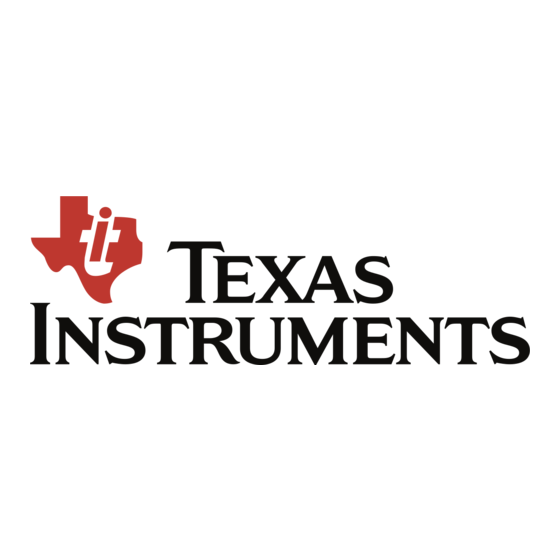
Advertisement
Quick Links
CC11xL 868/915 MHz Development Kit Quick Start Guide
Opening the Box and Running the Packet Error Rate Test
1. Kit Contents
2 x SmartRF™ Transciever EB (TrxEB)
2 x CC110LEM 868/915 MHz
1 x CC113LEM 868/915 MHz
1 x CC115LEM 868/915 MHz
1 x MSP430 Debug Probe (FET)
2 x Micro USB Cables
1 x Standard USB Cable
1 x 14-pin Flat Cable
The 868/915 MHz RF boards in this kit are FCC and IC certified
and tested to comply with ETSI/R&TTE over temperatures from
0 to +35°C.
FCC/IC Regulatory Compliance
FCC Part 15 Class A Compliant
IC ICES-003 Class A Compliant
(* picture may deviate)
4. Select Board Mode
Use the switches S1 and S2 to select the operating
mode of the board. For the sake of this quick start
guide, please select "Enable" and "UART". This
configuration will make it possible to communicate
directly with the MSP430 over a virtual COM port
on the PC.
7. Welcome Screen
Turn on power with the Main Power switch. You
should now see the Texas Instruments logo and a
short description of the buttons on the LCD.
Pushing any of the five buttons on the board will
take you to the main menu.
NB! If you don't see anything on the screen
make sure the mode switches are in the correct
positions (see step 4 above).
1
When using an external power supply, make sure it meets the listed requirements in addition to complying with applicable regional product regulatory and
safety certification requirements such as UL, CSA, VDE, CCC, and PSE.
2. TrxEB Overview
Power
EM
Board Mode
Selection
Breakout
Switches
Main
Power
Switch
USB
MSP430
Debug
Interface
MSP430
LCD
Breakout
Caution! The kit contains ESD sensitive
components.
prevent permanent damage.
5. Power Options
There are several ways of applying power to the
TrxEB.
2 x 1.5V AA Non-Rechargeable Alkaline
Batteries
USB (5V through USB plug)
External Power Supply (requirements below)
MSP430 Debugger
When the power source is batteries or USB, the
voltage regulators on the TrxEB will set the on-
board supply voltage to 3.3VDC.
1
External Power Supply
Requirements:
Nom Voltage: 3.3VDC
Max Current: 800 mA
Efficiency Level V
Warning! To minimize risk of personal injury or
property
damage,
never
batteries to power the board.
8. Packet Error Rate Test
Select the PER (Packet Error Rate) test by
highlighting the selection using the up/down
buttons. Confirm your selection by pressing Enter
(right button).
www.ti.com/lprf
Web sites:
E2E Forum:
www.ti.com/lprf-forum
3. Plug the EM into the TrxEB
EM
Connectors
Insert a CC110LEM into the TrxEB. Do not use
excessive force on the EM.
The EM has a PCB antenna, so there is no need
for an external antenna.
Buttons
LEDs
You can also use CC113L and CC115L for the Per
test, but note that CC113L is a receiver only and
CC115L is a transmitter only.
Handle
with
care
to
6. Select Power Source
Depending on the power source, make sure you
connect jumpers to the appropriate pins on the
"Power Source" header. For instance, if you use
batteries, use a jumper to short-circuit pin 1 and 2
on the header. The last jumper in the row (pin 9-
10) should always be mounted, unless the
MSP430 FET is used as the power source.
Note that there should only be one active
use
rechargeable
power source at any one time. Do not leave the
board powered when unattended.
9. Select Test Mode
The PER test can be run is several modes. Easy
Mode sets up a one-way test and uses default
settings. This test is convenient for practical range
testing.
The other test modes are described in the "TrxEB
RF PER Test Software Example User's Guide",
available on the kit web page.
To proceed, highlight "Easy Mode" and press Enter
(right button).
Make sure to subscribe to the Low-Power RF
Newsletter to receive information about updates to
documentation, new product releases, and more.
Sign up on the TI web pages.
SWRU292B
October 2013
Advertisement

Summary of Contents for Texas Instruments CC110L
- Page 1 Select the PER (Packet Error Rate) test by The PER test can be run is several modes. Easy should now see the Texas Instruments logo and a highlighting the selection using the up/down Mode sets up a one-way test and uses default short description of the buttons on the LCD.
-
Page 2: Troubleshooting
USB cable and start SmartRF Studio. download and install SmartRF Studio from Select the “Sub 1 GHz” tab and double click the www.ti.com/smartrfstudio. highlighted device icon (CC110L, CC113L or CC115L). -
Page 3: Regulatory Compliance Information
Any exceptions to this are strictly prohibited and unauthorized by Texas Instruments unless user has obtained appropriate experimental/development licenses from local regulatory authorities, which is responsibility of user including its acceptable authorization. - Page 4 FCC Interference Statement for Class B EVM devices This equipment has been tested and found to comply with the limits for a Class B digital device, pursuant to part 15 of the FCC Rules. These limits are designed to provide reasonable protection against harmful interference in a residential installation. This equipment generates, uses and can radiate radio frequency energy and, if not installed and used in accordance with the instructions, may cause harmful interference to radio communications.
- Page 5 Also, please do not transfer this product, unless you give the same notice above to the transferee. Please note that if you could not follow the instructions above, you will be subject to penalties of Radio Law of Japan. Texas Instruments Japan Limited (address) 24-1, Nishi-Shinjuku 6 chome, Shinjuku-ku, Tokyo, Japan http://www.tij.co.jp...
- Page 6 FDA Class III or similar classification, then you must specifically notify TI of such intent and enter into a separate Assurance and Indemnity Agreement. Mailing Address: Texas Instruments, Post Office Box 655303, Dallas, Texas 75265 Copyright © 2013, Texas Instruments Incorporated...










Need help?
Do you have a question about the CC110L and is the answer not in the manual?
Questions and answers